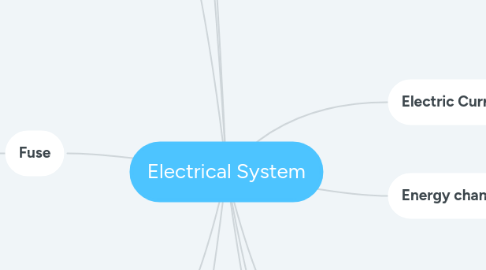
1. Electromotive force
1.1. Energy by the source in driving a unit charge around a complete circuit
2. Potential Difference
2.1. Energy to drive a unit charge through the opponent
2.2. Measuring
2.2.1. Voltmeter
2.2.2. Connected in parallel to the resistor
2.2.3. Electrical current flow into the voltmeter by the positive terminal and leave by the negative terminal
3. Resistors
3.1. Fixed Resistor
3.1.1. A conductor with known resistance, used to control current through the circuit
3.2. Variable Resistor
3.2.1. Moving the slider changes the resistance as the length of wire varies
3.3. Resistance
3.3.1. Ratio of the potential difference across it to the current flowing through it
3.3.2. Factors
3.3.2.1. The larger the cross-sectional area, the smaller is the resistance
3.3.2.1.1. Larger cross-sectional area has a lower resistance
3.3.2.1.2. Smaller cross-sectional area has a higher resistance
3.3.2.2. The longer the wire, the bigger the resistance
3.3.2.2.1. Shorter wire has a lower resistance
3.3.2.2.2. Longer wire has a higher resistance
4. Fuse
4.1. Short length of wire that melts and breaks the circuit when the current through it exceeds the fuse rating
4.2. It is to protect the appliance and cable from overheating by limiting the current that flows through it
4.3. It must be connected to live wire
4.4. If they is a fault and the current suddenly becomes too large, the fuse in the live wire melts and breaks the circuit. Thus, it disconnects from the high potential which prevents one from electric shock
5. Switch
5.1. Should be connected to live wire
5.1.1. When switch is off, appliance is disconnected form the high potential and prevents from an electric shock
5.2. If connected to a neutral wire
5.2.1. Appliance would still be a t high potential even though the switch is off and one would get electric shock if he come in contact
6. Wires
6.1. Live wire
6.1.1. Brown
6.2. Earth wire
6.2.1. Yellow and green stripes
6.3. Neutral Wire
6.3.1. BLue
7. Electric Current
7.1. Rate of flow of electric current
7.2. Produced when electric charge flows through a conductor and is carried by electrons
7.3. Measuring
7.3.1. Ammeter
7.3.2. Connected in series to the circuit
7.3.3. Current in a series circuit is the same
7.3.4. Electric current flow into the ammeter by the positive terminal and leave by the negative terminal
8. Energy change in Circuit
8.1. Electrical energy is supplied from source
8.1.1. Electrical energy is converted into other forms of energy by components in the circuit
8.1.1.1. Electrons return to the source to be supplied with energy again
8.2. Free electrons flowing around the circuit transfers energy from source to component
8.2.1. Source gives free electrons electrical energy it pushes out
8.2.2. Component when the electrons with electrical energy pass through a component the energy is converted to other forms
9. watt (W)
9.1. Power of an appliance is the amount of electrical energy converted to other forms of energy in one second
9.2. Sold in kilowatt (kWh)
9.3. Electrical energy (kWh) = (kW) x time (h)
10. Circuit Breaker
10.1. When too much current flows through it or there is a short circuit, it will trip which cuts off the electricity.
10.2. Connected to the live wire
10.2.1. Appliance is disconnected from the high potential which prevents one from electric shock
